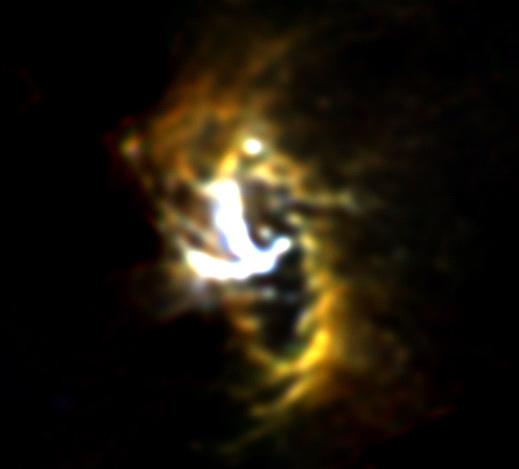I see a lot of amazing astronomical images, of course, so it takes a lot for one to surprise me. But the when I saw this one, I literally whispered “wow” out loud.
What you’re seeing there is a ring of dust circling the supermassive black hole in the center of the Milky Way! It’s about nine light years across, and heavily inclined, so it looks like an oval. The upside-down T is, quite possibly, material falling in from the ring toward the black hole itself.
Yegads.
Here’s the scoop. We live in a flat spiral galaxy, about 100,000 light years across. In the very center of the galaxy (and, so we think, in every big galaxy in the Universe) is a black hole, 26,000 light years from Earth. It’s huge: It has four million times the mass of the Sun. That’s big for a black hole, but I’ll note it’s teeny compared to the total mass of the galaxy, which is 400 billion or so times the mass of the Sun.
Still, it’s beefy, with a commensurate powerful gravitational field. There’s a lot of stuff in the galactic center that swirls around it, including stars, and clouds of gas and dust. That ring and fingers of material stretching on to the center seen above have been known for some time, but this is one of the best images I’ve seen of both together at the same time.
The picture was taken by the SOFIA telescope, which is—get this—a telescope with a 2.5 meter (9 foot) mirror mounted inside a Boeing 747 aircraft with a gigantic hole cut out of the side. Yes, seriously. At cruising altitude it gets above most of the water vapor in our atmosphere, which is critical: Water absorbs far-infrared light, which is what SOFIA is designed to detect. It actually has very sophisticated engineering to keep it pointed and stable, and the proof is in the pudding. Or in the image of the galactic circumnuclear ring, I suppose. And it’s still a lot cheaper than launching a telescope into space, so there’s that, too.

Image credit: NASA/DLR/USRA/DSI/FORCAST Team/Lau et al. 2013; NASA/ESA/STScI/AURA
By looking so far into the infrared it can peer through a lot of the dust and junk floating around in our galaxy that might otherwise block the view. The image above shows the SOFIA picture on the left, and on the right is the same view, but this time using the Hubble Space Telescope NICMOS infrared camera. It cannot see the ring because the material simply isn’t putting out light that Hubble can detect. All NICMOS sees are stars…though if you look, you can see places where there are fewer stars that correspond to places in the SOFIA image where the dust is. What SOFIA sees as bright actually blocks light for Hubble.

Image credit: NASA/DLR/USRA/DSI/FORCAST Team/Hankins et al. 2013
So why is that ring glowing in the far infrared? We think that a few million years ago there was a burst of star formation in the gas near the galactic center. A lot of high-mass, hot stars were born, and they energized the gas and dust in the region. Just 100 light years from the ring is the Quintuplet Cluster, seen here by SOFIA, suspected of being one of the sites of this stellar fecundity. In Hubble images you can see many stars that make up this cluster, but SOFIA sees the warm dust choking the cluster, heated by the newborn stars within. Each little blob is a thick cocoon of dust enshrouding hot young stars; the bigger circular feature is a shell of dust expelled by a very massive star that will soon end its life in a tremendous supernova explosion.
These pictures really amaze me. I tend to think of our galactic downtown as a busy place, but still, relatively quiet. I’ve written about what happens when these supermassive black holes actively gobble down matter: You get chaos, beams of matter blasting out at nearly the speed of light, bursts of high energy X- and gamma rays, and pretty much annihilation for anything with a few hundred light years. Our central supermassive black hole is (happily) pretty quiet as these things go, but that doesn’t mean it’s boring!
But then, black holes rarely are.
